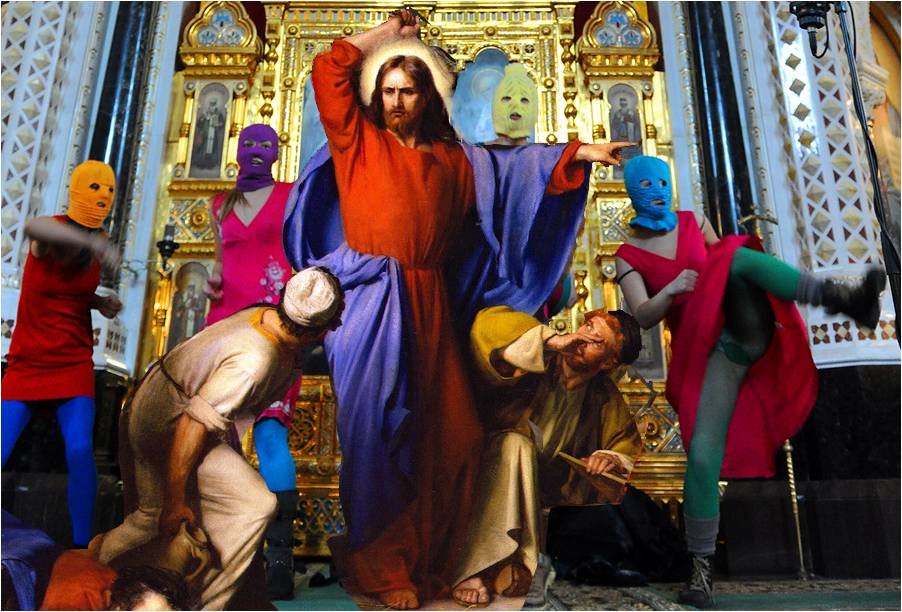 I’ve been asking afresh why the political and religious authorities of Jesus’ day thought it necessary to conspire in his death. What did he do or say that constituted a capital crime in their minds? It was certainly not because he preached love. The answer lies in two of Jesus’ most dramatic acts of performance art.
I’ve been asking afresh why the political and religious authorities of Jesus’ day thought it necessary to conspire in his death. What did he do or say that constituted a capital crime in their minds? It was certainly not because he preached love. The answer lies in two of Jesus’ most dramatic acts of performance art.
First came Jesus’ celebrated victory ride into Jerusalem on a donkey—an overt claim to kingship, referencing Zechariah 9. The second was his ‘occupy’-style protest in the so-called ‘cleansing of the temple.’ In fact, when Jesus overturned the tables, he was reenacting Jeremiah’s threat of the forthcoming destruction of the temple (by smashing pottery there, Jer. 19). Christ supplements his prophetic act of upheaval with the ‘little apocalypse’ (Mk.13), forecasting the demolition in which not one stone of the temple will be left on another. He delivers his ‘woes’ to the corrupt temple establishment and proceeds to occupy the grounds throughout Passion Week.
The combination of Jesus’ symbolic claim to kingship and his perceived threat to the temple were among the charges laid before the Sanhedrin and Pilate. The political and spiritual power brokers of Judea were responsible for keeping the peace during the Passover holiday, a volatile event considering the festival’s backstory of national deliverance. They saw Jesus’ capacity to attract and stir up crowds of enthusiasts as a real threat to public order, so they acted. Decisively. An arrest, a trial, a conviction and the sentence carried out in scarcely a day.
When I picture the temple incident, it’s a wonder that Jesus didn’t trigger a riot. He got rough. This was no spontaneous tantrum; he was deliberate, strategic. And yet … were his disciples and entourage so mesmerized that they just watched? Or did they join in the antics, upending tables and stalls as well? Why did the temple guards simply stand by? Why no immediate arrests? It must have been surreal.
I can’t help but comparing Jesus’ drama in the temple with the Pussy Riot incident (to see it, click here) in Moscow’s Christ the Savior Cathedral (Feb. 2012). The political punk band, Pussy Riot, donning bright colors and balaclavas, encroached on the sanctuary to perform a ‘punk prayer’ in which they sang (that’s generous) their dissent against church-state repression:
“Virgin Mary, Mother of God, put Putin away …
The Church’s praise of rotten dictators
The cross-bearer procession of black limousines …
Patriarch Gundyaev believes in Putin,
Better believe in God instead
The belt of the Virgin can’t replace mass-meetings
Mary the Mother of God is with us in protest!
Three members of the band were put on show-trial in Moscow, drawing global attention from such stars as Madonna and Lech Walesa. It culminated in a conviction and two year sentence for hooliganism intended to incite religious hatred.
On the face of it, we can read the Pussy Riot action as either a base act of sacrilegious anarchy or we can saint them as defenders of democratic freedom. It’s far more interesting to ponder the conspicuous similarities and notable differences between this case and Jesus’ temple episode.
The parallels are not insignificant. Both Jesus and Pussy Riot disrupted and seized temporary control of the religious space in their city’s major worship center. Both openly accused the religious leadership of corruption, complicity with political power, and oppression. And both initially got away with it before being arrested for disturbing the peace. Both invoked a higher religious standard but were accused of blasphemy. Both were popular with the people, a factor that pressed Pilate and Putin alike into calling for lighter sentences. In castigating Pussy Riot, one must ask whether they did anything different or worse than Jesus.
The contrasts are equally striking. Jesus’ trial was held quickly and largely in secret. His opponents had predetermined the outcome and according to St. Stephen the martyr, amounted to murder. All but a handful of Jesus’ followers fled in fear, abandoning him to incarceration, torture and an unjust crucifixion. By contrast, Pussy Riot’s legal hearing was an extended public affair. The momentum of popular support and media exposure grew every week with international pleas for lenience. Though the prosecutors asked for a three to seven year sentence, the women were given two years, including time served, which so far has included no mistreatment.
Some see their sentence as extreme given the crime. Perhaps as a one-off demonstration, they could have been condemned to attending regular church services politely for three months. But the need for a penalty with sharper teeth is also about freedom and rights—namely, protection of Orthodox believers to worship freely, without hindrance or disturbance. Without some significant deterrent, anarchist groups could effectively tyrannize every church, every week with impunity and immunity. That is, the punishment here may not fit the crime, but it may match the potential risk to future victims.
As it happens, this was the line Caiaphas took when he said, “It is better for you that one man die for the people than that the whole nation perish.” He considered the risk that a Jesus revolution could end in a nationwide bloodbath. Like the Russian courts, he sacrificed a scapegoat for the greater good of his people. Didn’t he?
—-
Brad Jersak is an author and theologian based in Abbotsford, BC. He serves on faculty at Westminster Theological Centre (UK) and is the editor of www.clarion-journal.com.


